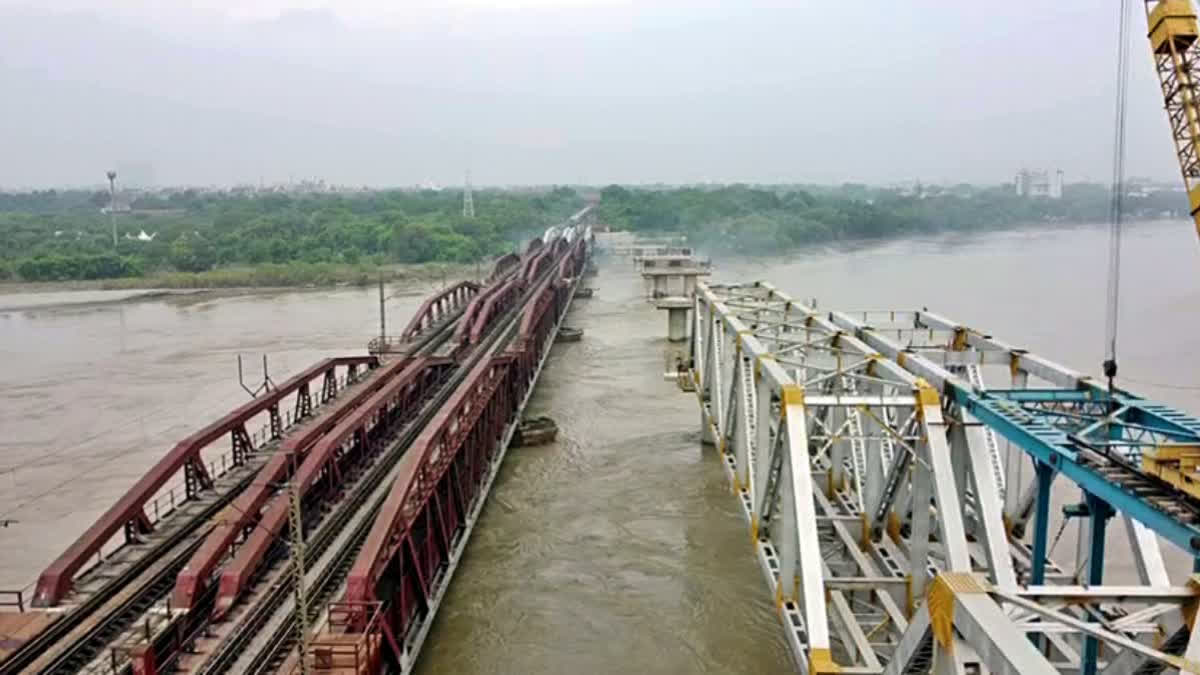Delhi: The water level of the Yamuna River in the national capital is likely to drop below the danger mark on Tuesday. The water level was recorded at 205.45 m at 6 am and will likely fall to 205 m by 6 pm, according to the Central Water Commission's projection.
Earlier on Monday, the Yamuna in Delhi flowed more than a metre above the danger mark of 205.33 m, with authorities suspending the movement of trains on the Old Railway Bridge (ORB). The water level of the river at the ORB has been mostly staying above the danger mark, after reaching an all-time high of 208.66 metres on July 13.
It breached the danger mark again on Sunday following a surge in the discharge from the Hathnikund barrage into the river after heavy rain in parts of Uttarakhand and Himachal Pradesh. A railway official said the movement of trains on the ORB has been suspended due to the increase in the water level of the Yamuna. "The route between Delhi and Shahdara will remain suspended and trains will be diverted via New Delhi," the official said.
Also read-Yamuna breaches danger mark again; another spell of floods anticipated in Delhi
The increase in the river's water level is expected to impact the ongoing relief-and-rehabilitation work in the flood-affected low-lying areas of the capital, officials said. According to the CWC data, the water level rose from 205.02 metres at 10 pm on Saturday to 206.57 metres at 3 am on Monday, before it started dropping again. On Monday, the water level dipped to 206.54 metres at 8 am.
The India Meteorological Department (IMD) has forecast heavy to very heavy rain in parts of Himachal Pradesh and Uttarakhand till July 25. According to the CWC data, the flow rate at the Yamunanagar-located Hathnikund barrage crossed the one lakh-mark at 9 am on Saturday and oscillated between two lakh and 2.5 lakh cusecs between 10 am and 5 pm.
Delhi irrigation and flood control department officials said the heavy rain in the upstream areas of the river will impact the rehabilitation of the affected families in the inundated low-lying areas of the capital and they may have to stay at relief camps for a longer period. It could also impact Delhi's water supply, which remained affected for four or five days in mid-July due to the inundation of a pump house at Wazirabad. The pump house supplies raw water to the Wazirabad, Chandrawal and Okhla treatment plants, which together account for around 25 per cent of the city's supply.
Also read-Delhi: Yamuna swells further, Old Railway Bridge shut for train traffic
Delhi grappled with unprecedented waterlogging and floods this month. Initially, a downpour caused intense waterlogging on July 8 and 9, with the city receiving 125 per cent of its monthly rainfall quota in just two days. Subsequently, heavy rain in the upper catchment areas of the Yamuna, including in Himachal Pradesh, Uttarakhand and Haryana, led to the river swelling to record levels.
At 208.66 metres on July 13, the Yamuna surpassed its previous record of 207.49 metres set in September 1978 by a significant margin. It breached embankments and penetrated deeper into the city than it has in more than four decades. The consequences of the floods have been devastating, with more than 27,000 people evacuated from their homes.
The losses incurred in terms of property, businesses and earnings have run into crores. Experts attribute the unprecedented flooding in Delhi to encroachment on the river floodplain, extreme rainfall within a short span of time and silt accumulation that has raised the river bed.
Also read-Delhi: Yamuna water-level continues to stay above danger mark



